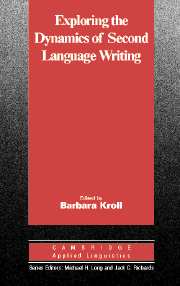Book contents
- Frontmatter
- Contents
- List of contributors
- Acknowledgments
- List of abbreviations used
- Series editors' preface
- Introduction: Teaching the next generation of second language writers
- I EXPLORING THE FIELD OF SECOND LANGUAGE WRITING
- II EXPLORING THE VOICES OF KEY STAKEHOLDERS:TEACHERS AND STUDENTS
- III EXPLORING WRITERS' FINISHED TEXTS
- IV EXPLORING CONTEXTUALITIES OF TEXTS
- V EXPLORING TECHNOLOGY
- EPILOGUE: EXPLORING OURSELVES
- Index
Introduction: Teaching the next generation of second language writers
Published online by Cambridge University Press: 05 October 2012
- Frontmatter
- Contents
- List of contributors
- Acknowledgments
- List of abbreviations used
- Series editors' preface
- Introduction: Teaching the next generation of second language writers
- I EXPLORING THE FIELD OF SECOND LANGUAGE WRITING
- II EXPLORING THE VOICES OF KEY STAKEHOLDERS:TEACHERS AND STUDENTS
- III EXPLORING WRITERS' FINISHED TEXTS
- IV EXPLORING CONTEXTUALITIES OF TEXTS
- V EXPLORING TECHNOLOGY
- EPILOGUE: EXPLORING OURSELVES
- Index
Summary
As a field of academic inquiry, the teaching of writing to second language (L2) learners sits at the junction of the discipline of composition and rhetoric (which concerns itself primarily with identifying the nature of texts and the processes that writers engage in to produce those texts) and the discipline of language learning (which concerns itself with cognitive and affective factors learners engage in as they move toward mastery of a particular linguistic code). No one teaching writing to this population of learners can responsibly serve his or her students without a clear recognition that these two fields intersect, especially at the postsecondary level. This volume is addressed to future L2 writing teachers; the authors of the chapters are steeped in traditions of inquiry central to composition and rhetoric and offer an applied linguistics perspective focused on adult learners.
A growing need for English teachers
If teaching second language skills to populations of adult students who grew up speaking other native languages was ever a simple matter for teachers, it is certainly no longer so in the twenty-first century. The complexity has been intensified by the phenomena known as “globalization” and the Internet revolution. They have brought such an expansion in the use of English throughout the world that one can only partly imagine the still unfolding ramifications, including the changing of the English language itself (Warshauer, 2000). Full participation in the world community, particularly within interconnected economic, technological, and geopolitical realities, can require a fluency in English that goes beyond the spoken language and embraces a variety of uses of the written language as well.
- Type
- Chapter
- Information
- Exploring the Dynamics of Second Language Writing , pp. 1 - 10Publisher: Cambridge University PressPrint publication year: 2003
- 3
- Cited by



